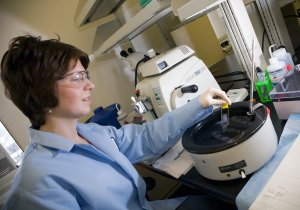Aug 6 2009
From creating a new business in digital pathology to developing next generation diagnostic imaging agents and life sciences tools that are breaking new ground in the detection and treatment of disease, the Biosciences technology organization at GE Global Research today celebrated its fifth anniversary. Since its formation in the summer of 2004, the group of 60 researchers has formed partnerships with world-class companies and research institutions, achieving key research milestones.
 Nicole Barnhardt, a biologist at GE's Global Research Center in Niskayuna, prepares tissue samples for biomarker detection. The study of biomarkers and their correlation to disease states such as cancer, is a key part of GE's innovative partnership with the Eli Lilly Company to develop advanced diagnostic tools that may predict cancer treatment responses to targeted drug therapies. Co-development of technologies that promote more personalized treatments is a key part of GE's Healthymagination initiative. (Photo: Business Wire)
Nicole Barnhardt, a biologist at GE's Global Research Center in Niskayuna, prepares tissue samples for biomarker detection. The study of biomarkers and their correlation to disease states such as cancer, is a key part of GE's innovative partnership with the Eli Lilly Company to develop advanced diagnostic tools that may predict cancer treatment responses to targeted drug therapies. Co-development of technologies that promote more personalized treatments is a key part of GE's Healthymagination initiative. (Photo: Business Wire)
"In just five years, we have built a world-class, state-of-the-art biomedical research facility in Upstate New York to keep GE at the forefront of healthcare innovation," said Mark Little, Senior Vice President and Director, GE Global Research. "Major breakthroughs have been achieved that are transforming health care and creating new business opportunities for GE that previously did not exist."
Christoph Hergersberg, Global Technology Leader for Biosciences, said, "It is so very rewarding to be a part of something as new and exciting as building a team from the ground up. What's even more exciting is watching these talented individuals achieve breakthroughs in diagnostic imaging, pathology and the life sciences.
Hergersberg added, "The vision today is the same as it was five years ago. Take GE's strength in diagnostic imaging systems and enable a whole new suite of products and technologies that will allow those systems to see and target disease with better specificity. In doing so, we are helping GE Healthcare to be better positioned to serve new markets and new customers, from pharmaceutical companies to medical specialists that are working with us to redefine what's possible in healthcare. "
The work being done by the Biosciences organization is a key component of GE's Healthymagination initiative, which is focused on driving new technologies and products that improve the cost, quality and access of healthcare. Today, the organization is comprised of five research labs with expertise in biological and organic chemistry; in vivo molecular imaging; computational biology; molecular and cell biology; and biochemistry and biological engineering.
By itself, GE's Biosciences organization resembles a small, start-up biotechnology company. In an industry where developments can take several years, even decades, the organization's achievements during its five-year history are noteworthy.
Some key research milestones include:
- March '09 - Optical Imaging: A multi-disciplinary team of engineers and scientists develop an optical imaging system to enhance the imaging of a tumor, real-time, during surgery. Researchers in the Biosciences organization have developed a special fluorescent agent that targets the tumor, including the tumor's margins, and enables it to be seen under the imaging device. The goal is to reduce cancer recurrence and improve patient outcomes. These tools could be available to surgeons in the operating room within 5 years.
- Sept '08 - Nanoparticle imaging agents: Researchers in GE's Nanotechnology Lab, working with the Biosciences organization, have developed promising nanoparticle-based imaging agents that could increase image resolution, sensitivity and could expand the use of traditional imaging systems, such as MRI, to see disease that cannot currently be detected. These agents are now being evaluated by the National Cancer Institute (NCI) as part of a research and development agreement..
- Nov '06 - $1,000 Human Genome: GE Global Research awarded funding from the National Human Genome Research Institute (NHGRI), part of the National Institutes of Health (NIH), to develop breakthrough technologies that enable a human-sized genome to be sequenced for under $1,000 and take less than one day to complete. With current technology, the cost is now estimated to be $50,000 and the time of sequencing takes several weeks. Click here to read the press announcement and here to read a blog from our lead scientist on the project.
History of the Biosciences Organization
The foundation for the Biosciences organization was established in 2002 when GE started a series of Advanced Technology (AT) programs at its Global Research Center. Among them was an AT program in Molecular Imaging, which represented GE's first official foray into the Biosciences. Also in 2002, Chairman and CEO Jeff Immelt announced a $150 million renovation of GE's Global Research Center headquarters in Niskayuna, NY that included the construction of a new building to house state-of-the art biomedical facilities The Biosciences labs encompass more than 40,000 square feet of biology and chemistry lab space.
In 2004, GE acquired Amersham, PLC, the world's leading company for imaging agents and cellular and protein research tools. Several researchers from Amersham joined Global Research and became a part of the Biosciences organization, which formally launched on August 6, 2004. The team has grown considerably since its establishment. Dozens of researchers were hired to reach its present total of more than 60 researchers.
Since forming the Biosciences Technology Organization, more than 50 patent applications have been filed related to novel agents that enhance the diagnostics process.